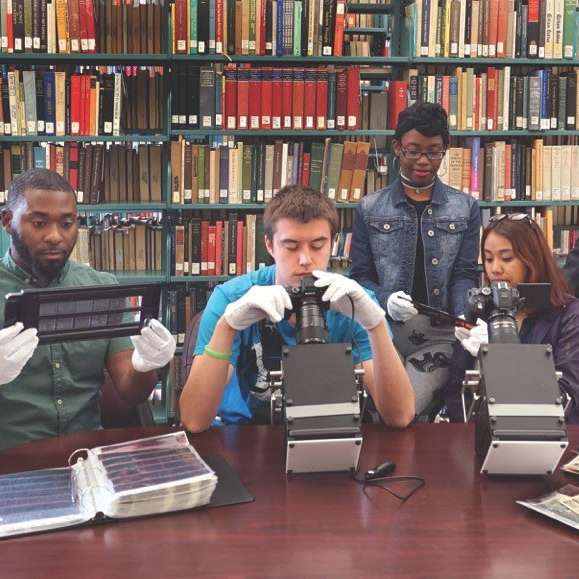
Getting to Know… Collections & Broadening Narratives
Discover more about our Collections program and Broadening Narratives strategy.
Photo: Student researchers at Claflin University work with a collection of photos from the collection of civil rights photographer Cecil Williams.
Our 5 Questions Getting to Know Series asks our program officers to provide an introduction to our work and insights about what is interesting and unique about each of our program areas.
By Jason Crowley and Ellen Placey Wadey
Why collections? And what do you mean by “Broadening Narratives?” What drove this change in strategy and approach to your collections work?
For decades, the stories that have been told through collections have been mostly rooted in subject matter expertise, with decisions being made by people who are not from the communities whose stories are being told.
The Gaylord and Dorothy Donnelley Foundation has always had an interest in supporting collecting organizations due to the family’s connection to the printing industry. Gaylord and Dorothy collected a large personal library throughout their lifetime and believed that preserving the material culture of a society was a way to ensure future generations could better understand and appreciate the knowledge of the past.
Through our Broadening Narratives program, we are working to ensure that those whose stories are being told through collections are included in the decisions about how those stories are told. And, we are working to broaden the kinds of narratives being told, paying particular attention to stories that have never been told, been told incompletely, or been told inaccurately.
What are some terms and concepts to understand when it comes to collections?
Collections: A collection is a group of objects—physical and/or digital—that have been gathered because of their like history, themes, or composition.
Archive: A place where historical or significant materials—physical and/or digital—are housed and preserved. An archive may have multiple collections within it.
Subject-matter expertise: Deep knowledge that is gained through extended study of a particular subject.
Lived experience: Those who understand an experience because they have grown up, worked, or have a personal identity with a particular subject.
Collecting Organization: Collecting organizations have historically been characterized as museums and libraries—places that hold and preserve collections. However, many organizations have collections: churches, schools, union halls, etc.
Cultural heritage organization: Cultural heritage organizations are ethnic, cultural, folk or other affinity organizations that promote the understanding of the history, traditions, and cultural expression of their communities.
Broadening Narratives seems to do things a little differently than the Foundation’s other programs. Why is this program project-based instead of general operating funds? And invitation-only instead of an open application?
The Foundation believes in the importance of general operating funding, but things in the collections world can operate a bit differently. To address the wide scope of projects requesting support, we offer project-based and time-limited support for our Broadening Narratives grants. Collections projects often take several years from inception to completion.
Because Broadening Narratives is encouraging a different kind of collections work—balancing subject-matter expertise with lived experience expertise, partnerships between smaller community-based organizations and large institutions, equity in resource sharing, exploration of under-represented narratives–we work with groups to help them develop their applications, usually through a series of conversations. This cooperative development in the resulting work is better supported by project-based funding.
-> Learn more about our grant guidelines
There seems to be a strong emphasis on partnerships and collaboration: what does this mean in a collections context? Any good examples of how it works?
Individual organizations and partnerships are eligible to apply. Because of our requirement that projects about a specific community must include representation from that community from the beginning—the decision-making stage—and not only at the end for audience development, many organizations choose to partner with one or more other organizations to achieve the balance of subject-matter expertise and lived-experience expertise. We also see partnerships that strike a strong balance between technical expertise and community connections shared between them.
A recently completed project involved a partnership with an art museum and a local LGBTQ+ community organization to develop an exhibition about the contributions of two LGBTQ+ artists on the Aesthetic Movement at the turn of the 20th century and its impact on the Charleston Renaissance. The partnership collaboration led to the successful exhibition and public programming that amplified an underrepresented narrative that has largely focused only on a few specific artists from a predominantly straight and wealthy segment of society.
How would you like to see the Broadening Narratives work develop and evolve?
Broadening Narratives is part of a new approach to collections work. There are many stories that have been told that need to be rethought. Many communities that have not been invited to the table are now encouraged to tell their own stories. The opportunity is huge. We’re committed to keep learning alongside the communities who bring their projects to us for support.
Bonus Question: Do you have any resources where I can learn more about Broadening Narratives?
Yes! Be sure to take a look at the video we produced when we launched the new Broadening Narratives strategy. (Note: Video contains some sequences with flashing lights.)


Sorry, the comment form is closed at this time.